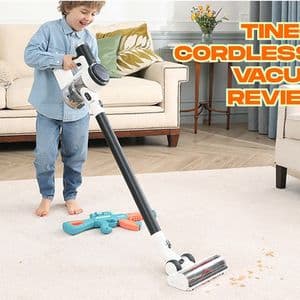Why Pet Hair Requires Special Cleaning Tools
Pet hair isn’t just a minor nuisance—it clings to fabrics, embeds into carpet fibers, and floats through the air. Standard vacuums often struggle because their brushes or suction mechanisms aren’t designed for fine strands. Small vacuums tailored for pet hair, however, are engineered with concentrated airflow and specialized attachments to capture fur more effectively.
Another factor is allergen control. Many pet owners deal with dander that can trigger allergies. A vacuum equipped with a HEPA filter traps these particles, improving air quality while cleaning. This makes the right vacuum a health investment, not just a cleaning tool.
The Core Features of a Pet-Friendly Small Vacuum
Not all compact vacuums deliver equal results. To choose wisely, it helps to focus on these critical aspects:
Strong Suction Power
Without sufficient suction, no vacuum can truly remove embedded fur. Some handheld vacuum with best suction models combine powerful motors with narrow nozzles, ensuring concentrated force that lifts even stubborn hair from upholstery and rugs.
Lightweight and Portable Design
Pet hair hides in awkward spots—like staircases, car interiors, and under couches. A lightweight build allows you to move the vacuum easily, reducing strain during extended cleaning sessions. Compact size also means it’s easier to store, especially in small apartments.
Specialized Attachments
Pet-specific attachments, such as rubber nozzles or motorized brushes, make a significant difference. These tools agitate fabrics to release trapped hair before suction pulls it away. Crevice tools are also handy for tight spaces where fur tends to accumulate.
Effective Filtration Systems
When vacuuming pet hair, filtration matters as much as suction. Vacuums with advanced filters capture not only fur but also dander and fine dust, preventing them from recirculating into your living space.
Read more: Top Rated Hand Vacuum
Benefits of Choosing a Small Vacuum for Pet Hair
Compact vacuums offer more than just portability. Their design makes them especially useful for quick cleanups. Unlike large upright machines, they’re ideal for spot-cleaning shedding zones like couches, pet beds, or car seats.
They also save energy—smaller motors use less power, but when engineered properly, they can still provide excellent performance. Another advantage is convenience: having a small vacuum nearby encourages frequent use, reducing the buildup of fur and allergens.
Comparing Small Vacuums to Other Cleaning Tools
You might wonder, why not just use a lint roller or traditional upright vacuum? While those tools have their place, they lack efficiency for certain jobs. Upright vacuums can be heavy and difficult to maneuver on stairs. Lint rollers, though handy, are impractical for large areas.
This is where small vacuums shine. They bridge the gap between convenience and effectiveness, giving pet owners a balanced solution for everyday cleaning.
Common Challenges Pet Owners Face
Even the best small vacuum can’t erase every cleaning challenge. Long-haired breeds shed heavily, meaning you may need to vacuum more frequently. Static electricity also causes fur to cling to fabrics. Regular maintenance, like brushing pets and emptying vacuum bins often, enhances results.
Storage is another challenge—some people underestimate how much pet fur accumulates. Emptying the dust container after each session prevents blockages and keeps suction strong.
Where Small Vacuums Work Best
Pet hair tends to accumulate in specific areas of the home. Knowing where to focus your cleaning makes a difference.
Stairs
Stairs are notorious for trapping fur in corners and along edges. That’s why many homeowners look for the best handheld vacuum for stairs and pet hair—it combines portability with strong suction, making each cleaning session more efficient.
Upholstery
Couches, recliners, and pet beds collect fur faster than you think. Using a specialized attachment helps lift embedded strands without damaging the fabric.
Cars
Pets often leave behind fur on car seats and floor mats. Compact vacuums with crevice tools are particularly effective in these tight spaces.
Tips for Maximizing Performance
-
Vacuum often: Frequent cleaning prevents hair from embedding deeply.
-
Use attachments correctly: Match the tool to the surface for better results.
-
Maintain filters: Washable or replaceable filters keep airflow strong.
-
Empty bins regularly: Overfilled containers reduce suction power.
-
Brush pets regularly: Reducing loose hair minimizes what ends up on floors and furniture.
Top Considerations Before Buying
If you’re evaluating a small vacuum for pet hair, ask yourself:
-
Do I need corded or cordless convenience?
-
How long should the battery last for each session?
-
What surfaces will I clean most often—stairs, furniture, or flooring?
-
Does the vacuum support washable filters for easy upkeep?
These factors help narrow your options and ensure you choose a model that aligns with your lifestyle.
The Role of Technology in Modern Vacuums
Today’s compact vacuums are far from basic. Innovations include smart sensors that adjust suction based on surface type, LED lights that reveal hidden fur, and cyclonic airflow systems that maintain power as the bin fills. These features show how technology continues to make cleaning easier for pet owners.
Final Thoughts
Keeping a home free of pet hair doesn’t have to be a constant struggle. With the right small vacuum for pet hair, you gain a reliable ally against shedding, dander, and stubborn fur. By focusing on suction strength, attachments, and portability, you can maintain cleaner floors, fresher air, and a more comfortable living space.
The key takeaway? Choose a vacuum that matches both your pet’s shedding habits and your cleaning routine. With that, your home stays fresh and fur-free—without the stress.










